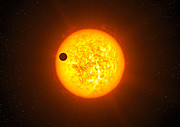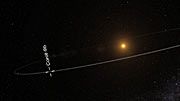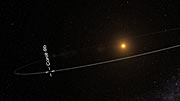Comunicato Stampa
Allo studio il primo esopianeta dal clima “temperato”
17 Marzo 2010
Combinando le osservazioni compiute dal satellite CoRoT con quelle dello strumento ESO HARPS, gli astronomi hanno scoperto di poter studiare in maniera approfondita il primo “normale” pianeta extrasolare (esopianeta). Chiamato Corot-9b, questo pianeta transita con regolarità davanti ad una stella simile al nostro Sole situata ad una distanza di 1500 anni luce dalla Terra in direzione della costellazione del Serpente.
“Questo è un normale e temperato pianeta extrasolare come dozzine altri ad oggi conosciuti, ma è però il primo le cui proprietà possiamo studiare approfonditamente - dice Claire Moutou, del team internazionale di 60 astronomi che ha fatto la scoperta, “e potrebbe rappresentare la Stele di Rosetta nel campo dello studio dei pianeti extrasolari.”
“Corot-9b è il primo esopianeta realmente paragonabile ai pianeti del nostro sistema” aggiunge il primo firmatario dello studio H.J. Deeg . “Ha le dimensioni di Giove e un'orbita simile a quella di Mercurio”.
“Al pari dei nostri pianeti giganti, Giove e Saturno, Corot-9b è composto principalmente da idrogeno ed elio ,” dice Tristan Guillot, membro del team , “e può contenere la massa di 20 pianeta Terra in altri elementi, inclusi acqua e rocce ad alte temperature e pressioni”.
Corot-9b passa davanti alla sua stella ogni 95 giorni, come si è visto dalla Terra [1]. Questo “transito” dura circa 8 ore e fornisce agli astronomi moltissime informazioni sul pianeta. L'aspetto favorevole è che questo gigante gassoso condivide molte caratteristiche con la maggior parte degli esopianeti scoperti finora [2].
“Le nostre analisi hanno fornito più informazioni su Corot-9b che per altri esopianeti dello stesso tipo ,” dice il coautore Didier Queloz “e può fornirci gli strumenti per studiare le atmosfere di pianeti con temperature moderate o basse e, in particolare, permetterci di aprire una finestra completamente nuova nella nostra comprensione della chimica alle basse temperature”.
Più di 400 esopianeti sono stati scoperti finora. 70 di loro con la metodologia del transito. Corot-9b è speciale perché la distanza dalla sua stella è circa dieci volte più grande di qualsiasi altro pianeta precedentemente scoperto con questo metodo. E diversamente da tutti gli altri esopianeti simili ha un clima temperato. La temperatura della sua superficie gassosa si ritiene compresa tra i 160 e i venti gradi celsius, con variazioni minime tra il giorno e la notte. La determinazione del valore esatto dipende dalla possibile presenza di uno strato di nuvole altamente riflessive.
Il satellite CoRoT, realizzato dal CNES, l'Agenzia Spaziale Francese [3], ha idetificato il pianeta dopo 145 giorni di osservazione durante l'estate del 2008. Le osservazioni realizzate con lo straordinario “cacciatore” di esopianeti dell'ESO - lo strumento HARPS unito al telescopio ESO di 3.6 metri di La Silla in Cile – ha permesso agli astronomi di misurare la sua massa, confermando che Corot-9b è nei fatti un esopianeta con una massa pari all'80% di quella di Giove.
Questa scoperta sarà pubblicata questa settimana su Nature.
Note
[1] Si definisce transito planetario quando un corpo celeste passa di fronte al suo sole e interrompe parte della luce della stella. Questo genere di eclissi provoca modifiche all'apparente brillantezza della stella medesima e rende possibile misurare il diametro del pianeta. Combinando questo dato con la sua velocità radiale, ottenuta grazie allo spettrografo HARPS, è possibile inoltre conoscere la massa del pianeta e, di qui, anche la sua densità. Questo insieme di misurazioni fa si che gli astronomi possano studiare questo oggetto nel dettaglio. Inoltre il fatto che “transiti”, ma non così vicino al suo sole da renderlo un “caldo Giove”, rende questo oggetto unico per ulteriori studi.
[2] I temperati giganti gassosi sono, finora, il più numeroso gruppo di esopianeti scoperti.
[3] Il telescopio spaziale CoRoT (Convection, Rotation and Transits) è stato realizzato dal CNES, con il contributo di Austria, Germania, Spagna, Belgio, Brasile e dell'Agenzia Spaziale Europea (ESA), ideato specificatamente per l'individuazione degli esopianeti in “transito” e effettuare studi sismologici delle stelle. I risultati di CoRoT sono implementati dalle osservazioni ottenute con alcuni telescopi terrestri, tra loro vi sono lo IAC-80 (Teide Observatory), il franco-canadese telescopio delle Hawaii (Hawaii),il telescopio Isacco Newton (Osservatorio Roque de los Muchachos), Wise Observatory (Israele), il telescopio Faulkes North dell'Osservatorio di Las Cumbres della y Global Telescope Network (Hawaii) e il telescopio ESO 3.6-metri (Cile).
Ulteriori Informazioni
Questa ricerca è stata presentata in un articolo pubblicato questa settimana su Nature. “A transiting giant planet with a temperature between 250 K and 430 K”, di H. J. Deeg et al.
Il team è composto da H.J. Deeg, B. Tingley, J.M. Almenara, e M. Rabus (Instituto de Astrofısica de Canarias, Tenerife, Spain), C. Moutou, P. Barge, A. S. Bonomo, M. Deleuil, J.-C. Gazzano, L. Jorda, e A. Llebaria (Laboratoire d'Astrophysique de Marseille, Université de Provence, CNRS, OAMP, France), A. Erikson, Sz. Csizmadia, J. Cabrera, P. Kabath, H. Rauer (Institute of Planetary Research, German Aerospace Center, Berlin, Germany), H. Bruntt, M. Auvergne, A. Baglin, D. Rouan, and J. Schneider (Observatoire de Paris-Meudon, France), S. Aigrain and F. Pont (University of Exeter, UK), R. Alonso, C. Lovis, M. Mayor, F. Pepe, D. Queloz, e S. Udry (Observatoire de l'Université de Genève, Switzerland), M. Barbieri (Università di Padova, Italia), W. Benz (Universität Bern, Switzerland), P. Bordé, A. Léger, M. Ollivier, e B. Samuel (Institut d’Astrophysique Spatiale, Université Paris XI, Orsay, France), F. Bouchy e G. Hébrard (IAP, Paris, France), L. Carone and M. Pätzold (Rheinisches Institut für Umweltforschung an der Universität zu Köln, Germany), S. Carpano, M. Fridlund, P. Gondoin, and R. den Hartog (ESTEC/ESA, Noordwijk, The Netherlands), D. Ciardi (NASA Exoplanet Science Institute/Caltech, USA), R. Dvorak (University of Vienna, Austria), S. Ferraz-Mello (Universidade de São Paulo, Brasil), D. Gandolfi, E. Guenther, A. Hatzes, G. Wuchterl, B. Stecklum (Thüringer Landessternwarte, Tautenburg, Germany), M. Gillon (University of Liège, Belgium), T. Guillot and M. Havel (Observatoire de la Côte d’ Azur, Nice, France), M. Hidas, T. Lister, and R. Street (Las Cumbres Observatory Global Telescope Network, Santa Barbara, USA), H. Lammer and J. Weingrill (Space Research Institute, Austrian Academy of Science), e T. Mazeh and A. Shporer (Tel Aviv University, Israel).
L’ESO (European Southern Observatory) è la principale organizzazione intergovernativa di Astronomia in Europa e l’osservatorio astronomico più produttivo al mondo. È sostenuto da 14 paesi: Austria, Belgio, Repubblica Ceca, Danimarca, Finlandia, Francia, Germania, Italia, Olanda, Portogallo, Spagna, Svezia, Svizzera e Gran Bretagna. L’ESO mette in atto un ambizioso programma che si concentra sulla progettazione, costruzione e gestione di potenti strutture astronomiche da terra che consentano agli astronomi di fare importanti scoperte scientifiche. L’ESO ha anche un ruolo preminente nel promuovere e organizzare cooperazione nella ricerca astronomica. L’ ESO gestisce tre siti unici di livello mondiale in Cile: La Silla, Paranal e Chajnantor. A Paranal, l’ESO gestisce il Very Large Telescope, l’osservatorio astronomico nella banda visibile più d’avanguardia al mondo. L’ESO è il partner europeo di un telescopio astronomico rivoluzionario, ALMA, il più grande progetto astronomico esistente. L’ESO sta pianificando al momento un Telescopio Europeo Estremamente Grande ottico/vicino-infrarosso di 42 metri, l’E-ELT, che diventerà “il più grande occhio del mondo rivolto al cielo”.
Die Übersetzungen von englischsprachigen ESO-Pressemitteilungen sind ein Service des ESO Science Outreach Network (ESON), eines internationalen Netzwerks für astronomische Öffentlichkeitsarbeit, in dem Wissenschaftler und Wissenschaftskommunikatoren aus allen ESO-Mitgliedsstaaten (und einigen weiteren Ländern) vertreten sind. Deutscher Knoten des Netzwerks ist das Haus der Astronomie am Max-Planck-Institut für Astronomie in Heidelberg.
Links
- Research paper
- Maggiori info: Exoplanet Media Kit
Contatti
Didier Queloz
Geneva Observatory, University of Geneva
Geneva, Switzerland
Tel.: +41 22 379 2477
E-mail: didier.queloz@unige.ch
Hans J. Deeg
Instituto de Astrofísica de Canarias
Tenerife, Spain
Tel.: +34 922 605 244
Cell.: +34 619 360 054
E-mail: hdeeg@iac.es
Claire Moutou
Laboratoire d'Astrophysique de Marseille
Marseille, France
Tel.: +33 4 91 05 59 66
E-mail: claire.moutou@oamp.fr
Henri Boffin
ESO La Silla-Paranal/E-ELT Press Officer
Garching, Germany
Tel.: +49 89 3200 6222
Cell.: +49 174 515 43 24
E-mail: hboffin@eso.org
Joerg Gasser (press contact Svizzera)
Rete di divulgazione scientifica dell'ESO
E-mail: eson-switzerland@eso.org
Sul Comunicato Stampa
| Comunicato Stampa N": | eso1011it-ch |
| Nome: | Corot-9b |
| Tipo: | Milky Way : Planet |
| Facility: | ESO 3.6-metre telescope, Very Large Telescope |
| Instruments: | HARPS, UVES |
| Science data: | 2010Natur.464..384D |
Our use of Cookies
We use cookies that are essential for accessing our websites and using our services. We also use cookies to analyse, measure and improve our websites’ performance, to enable content sharing via social media and to display media content hosted on third-party platforms.
ESO Cookies Policy
The European Organisation for Astronomical Research in the Southern Hemisphere (ESO) is the pre-eminent intergovernmental science and technology organisation in astronomy. It carries out an ambitious programme focused on the design, construction and operation of powerful ground-based observing facilities for astronomy.
This Cookies Policy is intended to provide clarity by outlining the cookies used on the ESO public websites, their functions, the options you have for controlling them, and the ways you can contact us for additional details.
What are cookies?
Cookies are small pieces of data stored on your device by websites you visit. They serve various purposes, such as remembering login credentials and preferences and enhance your browsing experience.
Categories of cookies we use
Essential cookies (always active): These cookies are strictly necessary for the proper functioning of our website. Without these cookies, the website cannot operate correctly, and certain services, such as logging in or accessing secure areas, may not be available; because they are essential for the website’s operation, they cannot be disabled.
Functional Cookies: These cookies enhance your browsing experience by enabling additional features and personalization, such as remembering your preferences and settings. While not strictly necessary for the website to function, they improve usability and convenience; these cookies are only placed if you provide your consent.
Analytics cookies: These cookies collect information about how visitors interact with our website, such as which pages are visited most often and how users navigate the site. This data helps us improve website performance, optimize content, and enhance the user experience; these cookies are only placed if you provide your consent. We use the following analytics cookies.
Matomo Cookies:
This website uses Matomo (formerly Piwik), an open source software which enables the statistical analysis of website visits. Matomo uses cookies (text files) which are saved on your computer and which allow us to analyze how you use our website. The website user information generated by the cookies will only be saved on the servers of our IT Department. We use this information to analyze www.eso.org visits and to prepare reports on website activities. These data will not be disclosed to third parties.
On behalf of ESO, Matomo will use this information for the purpose of evaluating your use of the website, compiling reports on website activity and providing other services relating to website activity and internet usage.
Matomo cookies settings:
Additional Third-party cookies on ESO websites: some of our pages display content from external providers, e.g. YouTube.
Such third-party services are outside of ESO control and may, at any time, change their terms of service, use of cookies, etc.
YouTube: Some videos on the ESO website are embedded from ESO’s official YouTube channel. We have enabled YouTube’s privacy-enhanced mode, meaning that no cookies are set unless the user actively clicks on the video to play it. Additionally, in this mode, YouTube does not store any personally identifiable cookie data for embedded video playbacks. For more details, please refer to YouTube’s embedding videos information page.
Cookies can also be classified based on the following elements.
Regarding the domain, there are:
- First-party cookies, set by the website you are currently visiting. They are stored by the same domain that you are browsing and are used to enhance your experience on that site;
- Third-party cookies, set by a domain other than the one you are currently visiting.
As for their duration, cookies can be:
- Browser-session cookies, which are deleted when the user closes the browser;
- Stored cookies, which stay on the user's device for a predetermined period of time.
How to manage cookies
Cookie settings: You can modify your cookie choices for the ESO webpages at any time by clicking on the link Cookie settings at the bottom of any page.
In your browser: If you wish to delete cookies or instruct your browser to delete or block cookies by default, please visit the help pages of your browser:
Please be aware that if you delete or decline cookies, certain functionalities of our website may be not be available and your browsing experience may be affected.
You can set most browsers to prevent any cookies being placed on your device, but you may then have to manually adjust some preferences every time you visit a site/page. And some services and functionalities may not work properly at all (e.g. profile logging-in, shop check out).
Updates to the ESO Cookies Policy
The ESO Cookies Policy may be subject to future updates, which will be made available on this page.
Additional information
For any queries related to cookies, please contact: pdprATesoDOTorg.
As ESO public webpages are managed by our Department of Communication, your questions will be dealt with the support of the said Department.




